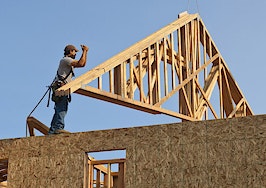Join industry visionaries Pete Flint, Spencer Rascoff, Ryan Serhant and more at Inman Connect New York, Jan. 24-26. Punch your ticket to the future by joining the smartest people in real estate at this must-attend event. Register here.
For most of the pandemic, perhaps no construction material has been the source of more public hand-wringing among homebuilding circles than lumber.
Shocks to the supply chain and elevated demand for new homes conspired to drive up lumber prices from $400 per thousand board feet in 2020 to as high as $1,500 for the same amount of wood just over a year later.
But since then, prices have careened back to earth, rocketed up again, and only in recent days settled back down near where they began in the first place.
Lumber futures on Thursday closed at $432.80 per thousand board feet, a mark now less expensive than what they traded for in February of 2020, according to Nasdaq.com. Prices continue to be volatile, but a steep decline in demand for new homes may finally be taking pressure off the strained supply chains that service homebuilders.
Lumber futures, last five years

Chart from Nasdaq.com
Lumber’s radical rise and fall illustrates the challenges that builders have faced for much of the pandemic.
In earlier months, builders had been scooping up more lumber than they needed, fearing that prices would only rise further. A top employee at a lumber wholesaler recently told The Wall Street Journal that this run on lumber is now over.
“All the urgency over the past two years — ‘give me everything you can’ — that’s basically over,” Michael Goodman, director of specialty products at Sherwood Lumber Corp., told the newspaper. “Lumberyards are not scared of the price going up.”
Still, just because lumber prices have come back down to earth doesn’t mean that all construction materials are affordable again.
As of August, goods that are inputs to residential construction remained 38 percent more expensive than they were in February of 2020, according to the U.S. Bureau of Labor Statistics’ producer price index.
While that number is down a bit off its high point in June, this broad basket of construction-material prices — of which lumber is only one component — remains significantly elevated. It includes materials like cement, brick, drywall and others that are essential for building new homes from the bottom up.
While reduction in lumber prices may in theory come as welcome news to builders, the continued volatility has proven to be a headache. The more understated fall in the cost of other materials has also kept construction costly.
Builders have become more pessimistic about the business climate in recent months as demand for new homes has fallen, and the outlook for future sales has worsened, according to the National Association of Home Builders’ monthly builder sentiment survey.













